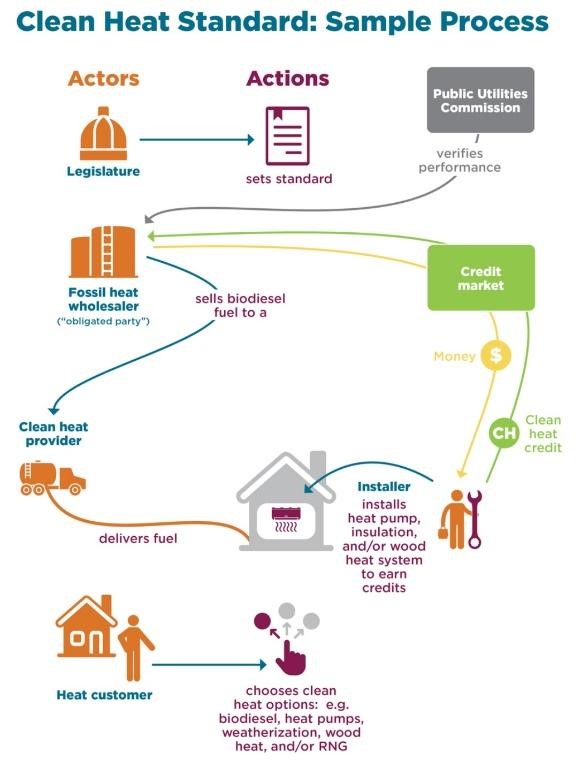

By Erin Cosgrove | Thu, April 28, 22
Vermont’s legislature is considering the first of its kind Clean Heat Standard (CHS). A Clean Heat Standard seeks to reduce and regulate emissions from natural gas, fuel oil, and propane distributors by creating a cap-and-trade mechanism. This mechanism operates similar to California’s transportation fuel cap-and-trade initiative and Colorado’s Clean Heat Standard for natural gas, but unlike both of these programs will regulate natural gas and delivered fuels used to heat homes.
This is a significant undertaking. To put some perspective on the amount of emissions this system will regulate, 72 percent of homes in the state heat with delivered fuels contributing to over one-third of Vermont’s greenhouse gas emissions. Reducing emissions from heating fuels in homes and buildings is not only good for the environment, but can help residents save money by ensuring less volatile price changes. Current estimates show that switching a home from propane to an efficient, electric cold climate heat pump can save the average Vermont homeowner about $900 per year.
This blog will break down the components of the Clean Heat Standard, including its gradual cap on emissions to help transition industry, its creation of a performance requirement to earn Clean Heat credits, and equity considerations embedded in its implementation.
Capping Emissions to Transition An Industry
The Clean Heat Standard is designed to support fuel suppliers in the state by creating predictable, incremental emission caps. In the initial years of the program, the cap will reduce emissions at a gradual rate starting at the pace of 4-5 percent per year. Additionally, the law mandates that the Public Utility Commission (Commission) establish credits in 10-year timeframes so that regulated entities have time to identify a compliance pathway. These incremental mandates, plus design of the clean heat credits described below, work to provide a pathway for the fossil fuel workforce to convert to a clean heat workforce, by delivering a gradually-increasing percentage of low-emission heating services to Vermont customers.
The transition from fuel distribution to clean energy delivery is already occurring for some businesses in Vermont. The Energy Co-op of Vermont started out selling fuel oil and kerosene but shifted to clean energy services, which now represents 40 percent of sales. Vermont Gas Systems (VGS) has started to sell, lease, install, and service heat pump water heaters for customers.
The Clean Heat Standard leaves regulated businesses across the state flexibility for compliance by providing a variety of measures they can use to achieve the cap. Similarly, the CHS provides options for customers and businesses that convert their heating systems, allowing them to choose from different clean heat technologies. Additionally, regulated businesses do not have to convert their business or train their workforce; instead, they may choose to pay for a delivery agent to install the obligated clean heat credits. Leaving these avenues open allows for businesses, residents, and the workforce to be a part of the clean energy transition in a way that best suits them.
Creating Performance Based Credits
Another unique aspect of the Clean Heat Standard is its creation of a performance based Clean Heat Credit market where companies earn credits through actions such as weatherization or installing cold climate heat pumps.
There are two ways to lower emissions with a cap-and-trade system – allowing providers to earn credits for positive actions or allowing providers to buy a limited pool of credits sold through an auction. Requiring positive actions to earn credits means there must be concrete, delivered solutions to meet the mandates of the program, similar to how renewable energy standards operate. Making regulated entities buy emission credits may not lead to direct action or change as a result of the programs. For example, the Regional Greenhouse Gas Initiative caps carbon emissions and sells them through an auction, but it is state investment of these proceeds into energy efficiency programs that creates lasting changes.
For the Clean Heat Standard in Vermont, clean heat credits are earned through installing measures that result in a reduction of greenhouse gas emission and directly reduces the combustion of fossil fuels in buildings. Ultimately, the Public Utility Commission will determine what measures will earn clean heat credits and the amount of clean heat credits that each measure receives. Eligible measures highlighted in the law include: weatherization and installation of cold climate heat pumps, as well as sustainable biofuels, renewable natural gas, efficient wood heating, and district heating services.
Ensuring Equity in Implementation
There are different ways to prioritize equity throughout the design and implementation process of cap-and-trade mechanisms, including prioritizing community engagement, embedding guardrails in program implementation, and prioritizing restorative justice in investments by empowering and investing in communities across the state.
The Clean Heat Standard uses two mechanisms to embed equity in implementation of the program – a performance target and an equity committee.
- A performance target requires the measures from clean heat credits be delivered to both low- and moderate- income customers. This policy can encourage the proactive design of programs to deliver benefits to underserved communities, helping to provide equitable access. For a performance target, the CHS requires that 16 percent of clean heat measures are delivered to low-income residents and 16 percent of measures are delivered to moderate-income residents.
- An equity committee or advisory group creates an avenue for full participation from all community members, supports distribution of decision-making power to historically marginalized communities, and allows for input from those most directly impacted by the energy landscape in implementation. For the CHS, the Equity Advisory Group’s role is to ensure that the low- and moderate- income performance target mandated by the law is achieved and to identify ways to ensure the program does not increase energy burden for residents of the state.
Conclusion
The Clean Heat Standard will be the first-of-its-kind cap-and-trade mechanism for the fossil fuel industry that seeks to not only lower emissions but encourage a whole industry to transition to a new clean energy workforce. Whether adopted in Vermont or another state in our region, the Clean Heat Standard could change the conversation when it comes to lowering emissions in the thermal building sector, and provides a new pathway for delivered fuels to be part of the climate transition.
To learn more about how cap and trade programs are implemented see NEEP’s Implementation Guide and Webinar.


